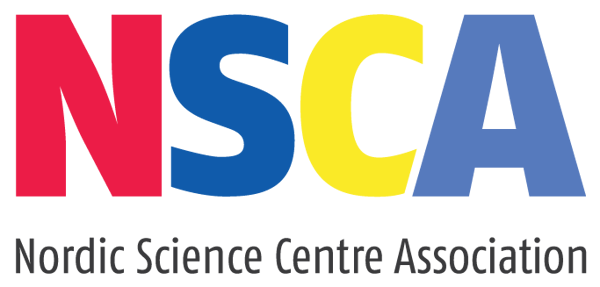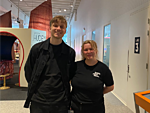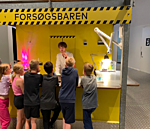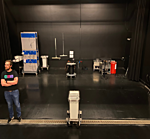After spending about a year in the “science communication world”, meeting others that share the same passion and have chosen the same path, I have figured I’m not alone in being motivated by making science fun, interesting and comprehensible. As I have worked with performing and developing our science shows at Trondheim Science Center, I have also been captured by the thought of reaching out with exciting science to as many people as possible. Picturing in my mind both bigger shows and maybe putting in the effort to start creating digital content for a wider audience.
This is part of the reason I wanted to visit Experimentarium in Copenhagen. From their website, I saw they had a well-functioning YouTube channel with engaging content published regularly over the last two years. This is a platform we have yet to put into use, and I wanted to hear their take on operating such a channel. Experimentarium also seemed to meet the audience with science demonstrations and shows in a slightly different way than what we were used to, which would be interesting to discuss.
I saw the NSCA Scholarship as an opportunity to make real my desire to see, learn and develop both how we work at our institution and myself, and was so fortunate to get my application approved. So, in the end of May 2023 me and my colleague got to meet Ida-Marie at Experimentarium, and here are some of the things we discussed, and the perspectives I left with.
Visit Experimentarium!
First things first, Experimentarium is an impressive, engaging, and super fun facility. Me and my colleague had the best time, was welcomed and guided by an accommodating Ida-Marie and left truly inspired. Would recommend a visit to Experimentarium if you have the chance.
Science demonstrations
After exploring the center on our own for a while, we paid a visit to the “The Experiment Bar”, located in the middle of the exhibition. Here, a pilot carries out a theme-based demonstration with experiments, lasting around 30 minutes. We saw a demonstration on CO2 and the greenhouse effect. A fun and well-structured experience, where the children present were very much involved. The demonstration is on the program 2-3 times a day, and the audience can come and go as they want.
In Trondheim we do something similar. Our “science busking trolley” is not listed in the program but pops up in the exhibition during the day, with small demonstrations and challenges. One difference is that the demonstrations in The Experiment Bar builds up on a theme, where the next experiment in some way connects to the previous. You could therefore identify both pros and cons with this being a drop in-activity.
However, even though smaller groups of children would show up or leave during the demonstration, the group present would as mentioned be very much involved in the experiments, which they in no doubt appreciated. There was neither an issue for those who came later to be captured by what was going on. As a mean to gather a larger portion of the visitors, I reflected with on whether it would be a good idea to announce over the speakers that the demonstration was about to begin. However, we discussed how more participants quickly can turn the activity into being a very different experience for those present, especially in a smaller booth like this. There was up to 7-8 children actively engaged during the demonstration, and they could all stand at the counter, getting a prime view of the experiments, including taking part in conducting them. In other words, trying to gather 10 more would probably make this more of a “look and listen”-experience for most of them.
YouTube
As mentioned, Experimentarium has an active YouTube-channel with around 1500 subscribers, where they have published 57 videos over the last two years. Ida-Marie tells us that it has created a lot of engagement, which is easy to see as several videos have reached a large audience. At the same time, we discuss some cost vs. benefits with a platform like YouTube, as the often time-consuming productions have no guarantee of reaching out to the targeted audience. Especially compared to platforms like TikTok or Instagram Reels, where the content is often way less time-consuming. To make a platform like YouTube work, you’ll need people who are dedicated and of course have the time and energy to make content regularly. It takes time to build a follower base.
What I am left with
So, what do I make of my visit to Experimentarium? I came to a vast science center with more space, models, visitors and employees than I am used to, with a thought in my head of learning about the work being done to reach out with exciting science to many people. Experimentarium does that in a great way, publishing engaging facts and experiments via their website and YouTube-channel, not to mention the various offers of workshops and instruction material accessible for schools.
What stuck with me, however, was the focus and priority of making the experience best possible for the individuals and the smaller groups. Just the mindset of not stressing with gathering the biggest crowd possible, but ensuring that for those present here and now, we will create something special. To be clear, I wouldn’t say that I haven’t possessed this perspective before, but I have been inspired to slow down before chasing the next big thing, and really appreciate the small meetings we get the chance to experience.
I had a science show for preschoolers recently, where there were only two families participating the early show. Getting to really meet two preschoolers, learning their names, seeing their smiles as a tea bag ignites and floats up into the air, is close to an unmatched joy which is not to be taken for granted. I might still pursue some dream of having thousands of viewers and subscribers, but I am in no rush, and meanwhile I will cherish encounters of any size.
Nikolai Ustad Bjurholt,
Science communicator from Trondheim Science Center
This is part of the reason I wanted to visit Experimentarium in Copenhagen. From their website, I saw they had a well-functioning YouTube channel with engaging content published regularly over the last two years. This is a platform we have yet to put into use, and I wanted to hear their take on operating such a channel. Experimentarium also seemed to meet the audience with science demonstrations and shows in a slightly different way than what we were used to, which would be interesting to discuss.
I saw the NSCA Scholarship as an opportunity to make real my desire to see, learn and develop both how we work at our institution and myself, and was so fortunate to get my application approved. So, in the end of May 2023 me and my colleague got to meet Ida-Marie at Experimentarium, and here are some of the things we discussed, and the perspectives I left with.
Visit Experimentarium!
First things first, Experimentarium is an impressive, engaging, and super fun facility. Me and my colleague had the best time, was welcomed and guided by an accommodating Ida-Marie and left truly inspired. Would recommend a visit to Experimentarium if you have the chance.
Science demonstrations
After exploring the center on our own for a while, we paid a visit to the “The Experiment Bar”, located in the middle of the exhibition. Here, a pilot carries out a theme-based demonstration with experiments, lasting around 30 minutes. We saw a demonstration on CO2 and the greenhouse effect. A fun and well-structured experience, where the children present were very much involved. The demonstration is on the program 2-3 times a day, and the audience can come and go as they want.
In Trondheim we do something similar. Our “science busking trolley” is not listed in the program but pops up in the exhibition during the day, with small demonstrations and challenges. One difference is that the demonstrations in The Experiment Bar builds up on a theme, where the next experiment in some way connects to the previous. You could therefore identify both pros and cons with this being a drop in-activity.
However, even though smaller groups of children would show up or leave during the demonstration, the group present would as mentioned be very much involved in the experiments, which they in no doubt appreciated. There was neither an issue for those who came later to be captured by what was going on. As a mean to gather a larger portion of the visitors, I reflected with on whether it would be a good idea to announce over the speakers that the demonstration was about to begin. However, we discussed how more participants quickly can turn the activity into being a very different experience for those present, especially in a smaller booth like this. There was up to 7-8 children actively engaged during the demonstration, and they could all stand at the counter, getting a prime view of the experiments, including taking part in conducting them. In other words, trying to gather 10 more would probably make this more of a “look and listen”-experience for most of them.
YouTube
As mentioned, Experimentarium has an active YouTube-channel with around 1500 subscribers, where they have published 57 videos over the last two years. Ida-Marie tells us that it has created a lot of engagement, which is easy to see as several videos have reached a large audience. At the same time, we discuss some cost vs. benefits with a platform like YouTube, as the often time-consuming productions have no guarantee of reaching out to the targeted audience. Especially compared to platforms like TikTok or Instagram Reels, where the content is often way less time-consuming. To make a platform like YouTube work, you’ll need people who are dedicated and of course have the time and energy to make content regularly. It takes time to build a follower base.
What I am left with
So, what do I make of my visit to Experimentarium? I came to a vast science center with more space, models, visitors and employees than I am used to, with a thought in my head of learning about the work being done to reach out with exciting science to many people. Experimentarium does that in a great way, publishing engaging facts and experiments via their website and YouTube-channel, not to mention the various offers of workshops and instruction material accessible for schools.
What stuck with me, however, was the focus and priority of making the experience best possible for the individuals and the smaller groups. Just the mindset of not stressing with gathering the biggest crowd possible, but ensuring that for those present here and now, we will create something special. To be clear, I wouldn’t say that I haven’t possessed this perspective before, but I have been inspired to slow down before chasing the next big thing, and really appreciate the small meetings we get the chance to experience.
I had a science show for preschoolers recently, where there were only two families participating the early show. Getting to really meet two preschoolers, learning their names, seeing their smiles as a tea bag ignites and floats up into the air, is close to an unmatched joy which is not to be taken for granted. I might still pursue some dream of having thousands of viewers and subscribers, but I am in no rush, and meanwhile I will cherish encounters of any size.
Nikolai Ustad Bjurholt,
Science communicator from Trondheim Science Center



